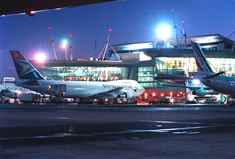SA airports gear up for 2010
Lavinia Mahlangu
21 July 2006South Africa's airports have embarked on a number of multi-billion rand projects to increase their capacity and efficiency ahead of the 2010 Fifa World Cup.
Airports Company South Africa (Acsa) has so far allocated R5.2-billion for infrastructure development at Johannesburg, Cape Town and Durban international airports.
Acsa's 10 airports currently handle more than 200 000 aircraft landings and 10 million departing passengers annually. As many as three million tourists are expected during the 2010 World Cup.
As Africa's largest and busiest airport, Johannesburg International Airport (JIA) has been allocated the biggest share - R3-billion - of Acsa's infrastructure budget.
More passengers, bigger planes
Key projects at JIA include a new R1.8-billion central terminal building that is expected to be completed by 2009. The facility will be equipped with infrastructure for baggage handling for the Airbus
A380 and will be connected to the Gautrain Rapid Rail Link for ease of access by rail.
The A380, officially unveiled in January last year, is currently the world's largest commercial aircraft, eclipsing the Boeing 747. The double-decker plane carries 555 passengers and is part of the fleets of Emirates, Lufthansa, Virgin Atlantic and Malaysia Airlines, among others.
Acsa is to spend R218-million on nine new aircraft stands at JIA, four of which will be able to accommodate the A380 and will be linked by dual air bridges to the new terminal.
A further R512-million will be spent on an "international pier" that will allow for a substantial increase in the number of passengers boarding and disembarking through air bridges.
The pier development will also provide additional passenger holding space and offer an expanded duty-free mall for international passengers. The pier will also include a bus station to serve departures to remotely parked aircraft.
Cape Town, Durban
Cape Town International Airport will get a R900-million new Central terminal building and a R100-million expansion to its existing parking bay, nearly doubling its capacity from 2 600 to 4 600 public bays.
A new R160-million multi-storey parkade, capable of accommodating 2 500 vehicles, is also scheduled to be operational from early 2007.
Durban International has begun construction of its R90-million, 1 500 bay multi-storey parkade. The first phase of the parkade is expected to be available for use by the end of 2006, with full occupation from 2007.
Acsa said plans were also in place to expand the existing terminal at Durban International and provide more check-in and baggage reclaim facilities.
Air transport 'key to economic growth'
Speaking at the Aviation Safety and Security Conference for Africa in Johannesburg on Wednesday, Transport Minister Jeff Radebe said the the Airlift
Strategy for South Africa, currently before Parliament, aimed to improve South African airlines' international competitiveness.
The strategy, arising from an assessment of the country's aviation constraints identified by the Accelerated and Shared Growth Initiative for SA, aims to grow the country's share of the international transport market and meet the tourism and trade sectors' requirements for cost-effective and efficient air services.
"Air transport has a growing impact on Africa's economies, generating about 470 000 direct and indirect jobs across the continent, and contributing over US$11.3-billion (R79.6-billion) to African GDP," Radebe said.
"If we add air transport-dependent tourism activities, then the number of jobs increases to over 3 million and the contribution to African GDP reaches some US$55.5-billion (R391.2-billion)."
In Africa, Radebe said, 40% of all jobs in the tourism sector were directly linked to air-borne tourism, compared to just four percent in the United States.
Source: BuaNews











